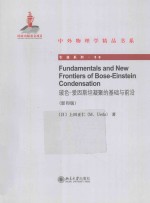图书介绍
玻色-爱因斯坦凝聚的基础与前沿=FUNDAMENTALS AND NEW FRONTIERS OF BOSE-EINSTEIN CONDENSATION 英文 影印版PDF|Epub|txt|kindle电子书版本下载

- 汤克夫编著 著
- 出版社:
- ISBN:
- 出版时间:2014
- 标注页数:0页
- 文件大小:32MB
- 文件页数:370页
- 主题词:
PDF下载
下载说明
玻色-爱因斯坦凝聚的基础与前沿=FUNDAMENTALS AND NEW FRONTIERS OF BOSE-EINSTEIN CONDENSATION 英文 影印版PDF格式电子书版下载
下载的文件为RAR压缩包。需要使用解压软件进行解压得到PDF格式图书。建议使用BT下载工具Free Download Manager进行下载,简称FDM(免费,没有广告,支持多平台)。本站资源全部打包为BT种子。所以需要使用专业的BT下载软件进行下载。如BitComet qBittorrent uTorrent等BT下载工具。迅雷目前由于本站不是热门资源。不推荐使用!后期资源热门了。安装了迅雷也可以迅雷进行下载!
(文件页数 要大于 标注页数,上中下等多册电子书除外)
注意:本站所有压缩包均有解压码: 点击下载压缩包解压工具
图书目录
1.Fundamentals of Bose-Einstein Condensation1
1.1 Indistinguishability of Identical Particles1
1.2 Ideal Bose Gas in a Uniform System3
1.3 Off-Diagonal Long-Range Order:Bose System6
1.4 Off-Diagonal Long-Range Order:Fermi System10
1.5 U(1)Gauge Symmetry11
1.6 Ground-State Wave Function of a Bose System13
1.7 BEC and Superfluidity15
1.8 Two-Fluid Model20
1.9 Fragmented Condensate23
1.9.1 Two-state model23
1.9.2 Degenerate double-well model25
1.9.3 Spin-1 antiferromagnetic BEC27
1.10 Interference Between Independent Condensates28
1.11 Feshbach Resonance31
2.Weakly Interacting Bose Gas33
2.1 Interactions Between Neutral Atoms33
2.2 Pseudo-Potential Method36
2.3 Bogoliubov Theory40
2.3.1 Bogoliubov transformations40
2.3.2 Bogoliubov ground state45
2.3.3 Low-lying excitations and condensate fraction48
2.3.4 Properties of Bogoliubov ground state50
2.4 Bogoliubov Theory of Quasi-One-Dimensional Torus54
2.4.1 Case of BEC at rest:stability of BEC55
2.4.2 Case of rotating BEC:Landau criterion56
2.4.3 Ground state of BEC in rotating torus59
2.5 Bogoliubov-de Gennes(BdG)Theory60
2.6 Method of Binary Collision Expansion65
2.6.1 Equation of state65
2.6.2 Cluster expansion ofpartition function66
2.6.3 Ideal Bose and Fermi gases67
2.6.4 Matsubara formula69
3.Trapped Systems73
3.1 Ideal Bose Gas in a Harmonic Potential73
3.1.1 Transition temperature75
3.1.2 Condensate fraction76
3.1.3 Chemical potential77
3.1.4 Specific heat77
3.2 BEC in One-and Two-Dimensional Parabolic Potentials79
3.2.1 Density of states79
3.2.2 Transition temperature79
3.2.3 Condensate fraction80
3.3 Semiclassical Distribution Function81
3.4 Gross-Pitaevskii Equation83
3.5 Thomas-Fermi Approximation84
3.6 Collective Modes in the Thomas-Fermi Regime88
3.6.1 Isotropic harmonic potential89
3.6.2 Axisymmetric trap91
3.6.3 Scissors mode92
3.7 Variational Method93
3.7.1 Gaussian variational wave function94
3.7.2 Collective modes96
3.8 Attractive Bose-Einstein Condensate98
3.8.1 Collective modes99
3.8.2 Collapsing dynamics of an attractive condensate102
4.Linear Response and Sum Rules105
4.1 Linear Response Theory105
4.1.1 Linear response of density fluctuations105
4.1.2 Retarded response function108
4.2 Sum Rules109
4.2.1 Longitudinal f-sum rule110
4.2.2 Compressibility sum rule112
4.2.3 Zero energy gap theorem114
4.2.4 Josephson sum rule115
4.3 Sum-Rule Approach to Collective Modes120
4.3.1 Excitation operators121
4.3.2 Virial theorem122
4.3.3 Kohn theorem123
4.3.4 Isotropic trap124
4.3.5 Axisymmetric trap127
5.Statistical Mechanics of Superfluid Systems in a Moving Frame129
5.1 Transformation to Moving Frames129
5.2 Elementary Excitations of a Superfluid131
5.3 Landau Criterion133
5.4 Correlation Functions at Thermal Equilibrium134
5.5 Normal Fluid Density136
5.6 Low-Lying Excitations of a Superfluid140
5.7 Examples141
5.7.1 Ideal Bose gas141
5.7.2 Weakly interacting Bose gas143
6.Spinor Bose-Einstein Condensate145
6.1 Internal Degrees of Freedom145
6.2 General Hamiltonian of Spinor Condensates146
6.3 Spin-1 BEC151
6.3.1 Mean-field theory of a spin-1 BEC153
6.3.2 Many-body states in single-mode approximation157
6.3.3 Superflow,spin texture,and Berry phase161
6.4 Spin-2 BEC163
7.Vortices171
7.1 Hydrodynamic Theory of Vortices171
7.2 Quantized Vortices174
7.3 Interaction Between Vortices180
7.4 Vortex Lattice181
7.4.1 Dynamics of vortex nucleation181
7.4.2 Collective modes of a vortex lattice183
7.5 Fractional Vortices186
7.6 Spin Current187
7.7 Fast Rotating BECs189
7.7.1 Lowest Landau level approximation189
7.7.2 Mean field quantum Hall regime192
7.7.3 Many-body wave funetions of a fast rotating BEC194
8.Fermionic Superfluidity197
8.1 Ideal Fermi Gas197
8.2 Fermi Liquid Theory200
8.3 Cooper Problem205
8.3.1 Two-body problem205
8.3.2 Many-body problem209
8.4 Bardeen-Cooper-Schriefier (BCS) Theory211
8.5 BCS-BEC Crossover at T=0215
8.6 Superfluid Transition Temperature219
8.7 BCS-BEC Crossover at T≠0221
8.8 Gor'kov-Melik-Barkhudarov Correction225
8.9 Unitary Gas228
8.10 Imbalanced Fermi Systems231
8.11 P-Wave Superfluid234
8.11.1 Generalized pairing theory234
8.11.2 Spin-triplet p-wave states238
9.Low-Dimensional Systems241
9.1 Non-interacting Systems241
9.2 Hohenberg-Mermin-Wagner Theorem243
9.3 Two-Dimensional BEC at Absolute Zero246
9.4 Berezinskii-Kosterlitz-Thouless Transition247
9.4.1 Universal jump247
9.4.2 Quasi long-range order249
9.4.3 Renormalization-group analysis250
9.5 Quasi One-Dimensional BEC252
9.6 Tonks-Girardeau Gas256
9.7 Lieb-Liniger Model258
10.Dipolar Gases261
10.1 Dipole-Dipole Interaction261
10.1.1 Basic properties261
10.1.2 Order of magnitude and length scale263
10.1.3 D-wave nature264
10.1.4 Tuning the dipole-dipole interaction265
10.2 Polarized Dipolar BEC266
10.2.1 Nonlocal Gross-Pitaevskii equation266
10.2.2 Stability267
10.2.3 Thomas-Fermi limit269
10.2.4 Quasi two-dimensional systems271
10.3 Spinor-Dipolar BEC273
10.3.1 Einstein-de Haas effect274
10.3.2 Flux closure and ground-state circulation274
11.Optical Lattices277
11.1 Optical Potential277
11.1.1 Optical trap277
11.1.2 Optical lattice280
11.2 Band Structure283
11.2.1 Bloch theorem283
11.2.2 Brillouin zone285
11.2.3 Bloch oscillations286
11.2.4 Wannier function287
11.3 Bose-Hubbard Model288
11.3.1 Bose-Hubbard Hamiltonian288
11.3.2 Superfluid-Mott-insulator transition289
11.3.3 Phase diagram291
11.3.4 Mean-field approximation292
11.3.5 Supersolid295
12.Topological Excitations297
12.1 Homotopy Theory297
12.1.1 Homotopic relation297
12.1.2 Fundamental group299
12.1.3 Higher homotopy groups302
12.2 Order Parameter ManifoId303
12.2.1 Isotropy group303
12.2.2 Spin-1 BEC304
12.2.3 Spin-2 BEC305
12.3 Classification of Defects306
12.3.1 Domains306
12.3.2 Line defects306
12.3.3 Point defects311
12.3.4 Skyrmions313
12.3.5 Influence of different types of defects316
12.3.6 Topological charges318
Appendix A Order of Phase Transition,Clausius-Clapeyron Formula,and Gibbs-Duhem Relation321
Appendix B Bogoliubov Wave Functions in Coordinate Space323
B.1 Ground-State Wave Function323
B.2 One-Phonon State327
Appendix C Effective Mass,Sound Velocity,and Spin Susceptibility of Fermi Liquid329
Appendix D Derivation of Eq.(8.155)333
Appendix E f-Sum Rule335
Bibliography337
Index347